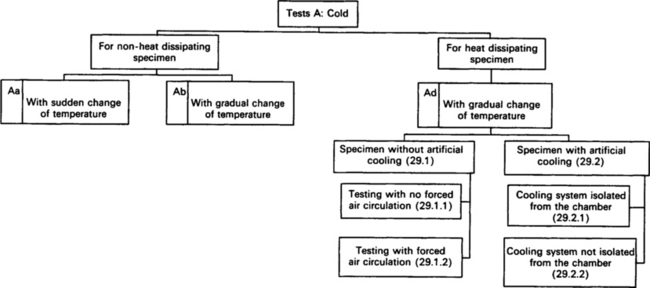Ambient temperature
2.1 Guidance
2.1.1 What is ambient temperature?
Temperature, humidity, rainfall, wind velocity and the duration of sunshine all affect the climate of an area. These elements are in turn the result of the interaction of a number of determining causes, such as latitude, altitude, wind direction, distance from the sea, relief, and vegetation. Elements and their determining causes are similarly interrelated which also contribute to temperature changes, for example the length of day is a factor which helps to determine temperature; however, the duration of actual sunshine is an element with far-reaching effects on plant and animal life.
Of all the elements that have an effect on man and equipment none is more vital to living organisms than temperature. Temperature has a large influence on where humans live and in the areas where they work. Protective housing or artificial heat sources may overcome low temperatures (and high altitudes); similarly cooling devices and reflective coatings protect equipment from high temperatures. Temperature is therefore a particularly important aspect of the environment and its accurate measurement and statement are matters requiring careful attention.
There are two possible sources from which the temperature at the Earth’s surface may be derived. The first, and most important, source of temperature is the sun (heat rays from the sun are the most important manifestation of solar energy) and the second is the interior of the Earth.
The ambient temperature at any given time is the temperature of the air measured under standardised conditions and with certain recognised precautions against errors introduced by radiation from the sun or other heated bodies. Temperature figures with respect to climate are generally ‘shade’ temperatures (i.e. the temperature of the air measured with due precautions taken to exclude the influence of the direct rays of the sun) and it is usual for the temperature to be much higher in direct sunshine. Many mountain areas have air temperatures in the region of zero in winter but the presence of bright sunshine produces a feeling of warmth and permits the wearing of light clothing.
Seasonal fluctuations in temperature do not pass below ground deeper than 60–80 ft. Below that depth borings and mineshafts indicate that the temperature increases (downwards) depending on the geographical position, location and depth. On average, however, a rise of about 1°F may be taken for each 64 ft of descent. Assuming that this rate of increase is maintained, it stands to reason that the interior of the Earth must be excessively hot and, therefore, it must warm the surface to some extent. It is not possible to determine the precise influence of this temperature increase but it has an effect on tunnels at a depth greater than 80 ft. As the heat from the core is virtually negligible on the surface of the Earth (compared with that of the sun), it has not been considered here and the only source of heat that has been taken into account is the sun.
The difference between summer and winter temperatures of any locality is known as the ‘annual range of temperature’ of that locality. It is the difference between the highest and lowest temperatures ever experienced at the place in question (it may also be referred to as the ‘absolute range of temperature’). The maximum and minimum temperatures are not the same every year and, should their average over a series of years be taken, it would be known as the ‘mean annual extreme range’.
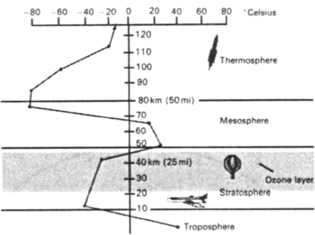
Fig. 2.3 Temperature changes above the Earth’s surface (reproduced from Microsoft Encarta 98 Encyclopedia Deluxe edition)
Although air near the surface, especially at night, may be cooler than the air just above it there is generally a gradual falling off of temperature from the ground level up. Over thousands of feet this cooling averages 1°F per 300 ft and thus at approx. 25–55 000 ft (five to 10 miles) above the ground the temperature will be down to 55–60°F below zero. Above this the air temperature ceases to fall off regularly, in fact it may even rise for a bit. Usually, however, it remains fairly constant and is, on this account, sometimes referred to as the isothermal layer. To meteorologists and airmen it is known as the stratosphere. The lower layers of the atmosphere, where temperature falls off with height, commonly go by the name of the troposphere. The boundary layer between the two is called the tropopause.
2.1.2 Introduction
When equipment has been installed without any protection it can be expected to be exposed to more extreme air temperatures and more severe combinations of air temperatures and relative humidities than a similar piece of equipment that has been installed or housed in a temperature controlled environment.
In addition to open air temperature, temperature stresses on equipment depend on a number of other environmental parameters (e.g. solar radiation, heating from adjacent equipment and air velocity, etc.) and these must be taken into account when designing and manufacturing equipment.
The performance of equipment is also influenced and limited by the internal temperature of the equipment. Internal temperatures, in turn, depend on the external ambient conditions and the heat generated within the device itself. Indeed, whenever a temperature gradient exists within a system formed by a device and its surrounding environment, a process of heat transfer will ensue.
Thus in any generic (or system specific) specification or standard related to ambient temperature it is necessary to consider the:
• operating temperature range – the specified operating temperature for the equipment which must always be the lowest and the highest ambient temperature expected to be experienced by the equipment during its normal operation;
• storage temperature range – the specified storage temperature that is always the lowest and the highest ambient temperature that the equipment is expected to experience (with the power turned off) during storage or from exposure to climatic extremes.
Note: The equipment is not normally expected to be capable of operating at these extreme temperatures, merely survive them without damage.
Note: The use of the words ‘shall’ and ‘should’ in the context of national, European and international specifications is normally accepted as ‘mandatory’ and ‘preferable’, respectively.
2.1.3 Test standards
The following are the most frequently used ambient temperature tests that equipment is required to pass.
| IEC 68.2.1 | Environmental testing procedures – Test A: Cold |
| IEC 68.2.2 | Environmental testing procedures – Test B: Dry heat |
| IEC 68.2.14 | Environmental testing procedures – Test N: Change in temperature |
| IEC 68.2.41 | Environmental testing procedures – Tests Z/BM: Combined dry heat/low air pressure |
| IEC 68.2.61 | Environmental testing procedures – Test Z/ABDM: Climatic sequence |
2.1.4 Other related standards and specifications
| IEC 68.1 | Environmental testing procedures – General and guidance |
| IEC 68.2.13 | Environmental testing procedures – Test M: Low air pressure |
| IEC 68.2.28 | Environmental testing procedures – Guidance’ Damp heat tests |
| IEC 68.2.3 | Environmental testing procedures – Test Ca: Damp heat, steady state |
| IEC 68.2.30 | Environmental testing procedures – Test Db and guidance: Damp heat cyclic (12 + 12 hour cycle) |
| IEC 68.2.33 | Environmental testing procedures – Guidance on change of temperature tests |
| IEC 68.2.38 | Environmental testing procedures – Test Z/AD: Composite temperature/humidity cyclic test |
| IEC 68.2.39 | Environmental testing procedures – Test Z/AMD: Combined sequential cold, low air pressure and damp heat test. (Note: mainly for high altitude applications) |
| IEC 68.2.40 | Environmental testing procedures – Test Z/AM: Combined cold low air pressure tests |
| IEC 68.2.50 | Environmental testing procedures – Test Z/Afc: Combined cold vibration (sinusoidal) tests for both heat dissipating and non-heat dissipating specimens |
| IEC 68.2.51 | Environmental testing procedures – Test Z/BFc: Combined dry heat vibration (sinusoidal) tests for both heat dissipating and non-heat dissipating specimens |
| IEC 68.2.56 | Environmental testing procedures – Test Cb: Damp heat, steady state, primarily for equipment |
| IEC 68.3.1/1A | Environmental testing procedures – Background information-Cold and dry heat tests (and supplement) |
| IEC 68.3.2 | Environmental testing procedures – Background information – Combined temp./low air pressure tests |
| IEC 68.4.4 | Environmental testing procedures – Information for specification writers-Test summaries |
| IEC 721.2.1 | Classification of environmental conditions – Environmental conditions appearing in nature – Temperature and humidity |
| IEC 721.2.3 | Classification of environmental conditions – Environmental conditions appearing in nature-Air pressure |
| IEC 721.3.0 | Classification of environmental conditions – Classification of groups of environmental parameters and their severities-Introduction |
2.2 Typical contract requirements – ambient temperature
The requirement for equipment to conform to various environmental specifications is becoming commonplace in today’s contracts. More and more specifications are being used to describe the various conditions that equipment is likely to experience when being used, stored or whilst in transit.
The following are the most common environmental requirements found in modern contracts concerning ambient temperature.
2.2.2 Temperature ranges
Equipment has to be designed and manufactured to meet the full performance specification requirement for the selected temperature category. Typical ranges are shown in Tables 2.1 to 2.3 (see pages 46 to 50) which have been extrapolated from IEC 721. Deviations from these temperature tables are normally subject to agreement between purchaser and supplier.
Table 2.1

1The choice of classification is dependent upon the type of climate in which the equipment will be installed.
Table 2.2
Ambient temperature – transportation

1The choice of classification is dependent upon the type of climate in which the equipment will be installed.
Table 2.3
Ambient temperature – operational
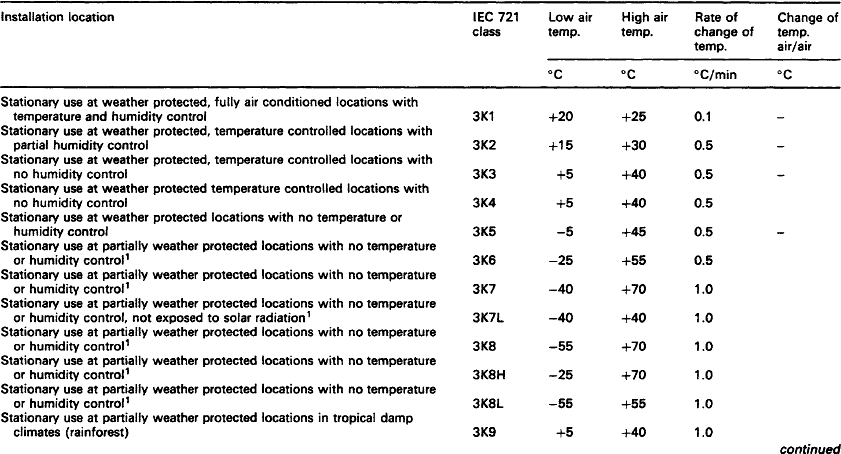
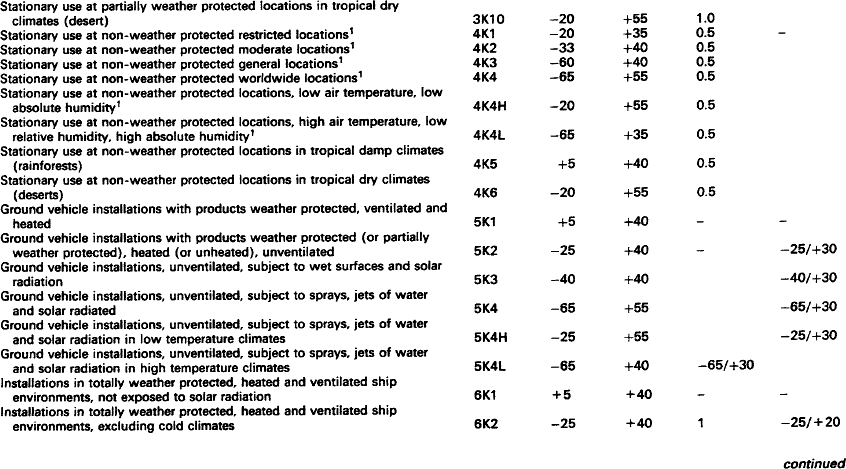

1The choice of classification is dependent upon the type of climate in which the equipment will be installed.
2.2.3 Temperature increases
The design of equipment should always take into account temperature increases within cubicles and equipment cases so as to ensure that the components do not exceed their specified temperature ranges.
2.2.4 Temperature variations
Rapid external ambient temperature variations resulting from moving equipment through tunnels, etc. (e.g. railway mounted equipment) should be taken into account. It should be noted that it is normal for the rate of change of external temperature to be assumed to be 3°C/sec with a maximum variation of 40°C.
2.2.5 Temperature stresses
In addition to open air temperature, temperature stresses on equipment caused by other environmental parameters (e.g. solar radiation, air velocity and heating from adjacent equipment) need to be considered.
2.2.6 Operational requirements
The following are normal operating requirements found in most contracts:
• the specified operating temperatures are the lowest and the highest ambient temperatures expected to be experienced by equipment during normal operation;
• when equipment is turned on it is expected to operate within the temperature ranges stipulated and be fully operational within a specified time after initial turn-on unless otherwise specified;
• the permissible limit temperatures of the operating equipment are not allowed to be exceeded as a result of the temperature rise occurring in operation (including temporary acceleration).
Note: The limit temperature of operating equipment is normally the maximum or minimum temperature at which no ‘disadvantageous change or deformation of operating equipment’ occurs. Ambient temperature is the temperature closest to the element (i.e. where it is positioned).
2.2.7 Storage
After storage equipment will be expected to function in accordance with the procuring specification, without failure and be capable of passing the high and low level temperature tests as well as the temperature shock tests.
The specified storage temperatures are normally the lowest and highest ambient temperatures that the sample is expected to experience (with the power turned off) during storage or exposure to climatic extremes. The equipment is not expected to be capable of operating at these extreme temperatures, but to survive them without damage.
2.2.8 Peripheral units
For peripheral units (measuring transducers, etc.) or situations where equipment is in a decentralised configuration, ambient temperature ranges are frequently exceeded. In these cases the actual temperature occurring at the location of the equipment concerned needs to be used in the design.
2.2.9 Installation
When equipment is installed in a controlled climatic environment, provided the equipment is not required to operate outside of those conditions, the temperature range can normally be agreed between purchaser and supplier.
2.2.10 Tests
2.2.10.1 Production configuration
All proposed candidate equipment, components or other articles will need to be tested in their production configuration without the use of any additional external devices that have been added expressly for the purpose of passing temperature testing.
2.2.10.2 Procuring specifications
When tested, the sample (component, equipment or other article) will be expected to perform as stipulated in the procuring specification and over the designated temperature range.
2.2.10.3 Test methods
Test methods for determining the suitability of a specimen normally include:
| IEC 68.2.1 | Environmental testing procedures – Test A: Cold |
| IEC 68.2.14 | Environmental testing procedures – Test N: Change in temperature |
| IEC 68.2.2/2A | Environmental testing procedures – Test B: Dry heat (plus supplement) |
| IEC 68.2.41 | Environmental testing procedures – Test Z/BM: Combined dry heat/low air pressure |
| IEC 68.2.61 | Environmental testing procedures – Test Z/ABDM: Climatic sequence |
Note: Other tests can be specified from those shown in Section 2.4.
2.3 Values and ranges
Guidance on geographical values and ranges of temperature (i.e. limits of statistical open-air climate) has been taken from the latest issue of the IEC 721 standard. These figures are based on observations over a period of not less than 10 years and represent conditions frequently met by products whilst being transported, stored, installed or used.
Except where stated, all values given represent the maximum and minimum temperature requirements for that particular equipment, location and situation.
Deviation from the temperature table is normally subject to acceptance by demonstration that the equipment is suitable for service and by agreement between the purchaser and the supplier.
2.3.1 Ship environment
The ship environment (as described in IEC 721.3.6) classifies groups of environmental parameters and their severities that a product is subjected to when permanently or temporarily installed aboard a ship, including:
• ships propelled by mechanical means, including mobile offshore units (see also IEC 92.10);
• ships not propelled by mechanical means (including sailing boats and liferafts).
The classes defined in this standard are applicable to all sizes of ships from pleasure craft to trawlers, ferry boats, icebreakers, cargo ships (including tankers) whilst operating in:
2.3.2 Environmental conditions in tropical areas
In the tropics (i.e. between 23°27’ south and 23°27’ north) it is normal to find daytime high temperatures, frequently combined with high precipitation. There are very few changes but the tropical climate extends from warm damp climatic conditions (in tropical rainforests at the equator) to a warm dry climate (in the deserts near the tropics).
The basic environmental conditions found in the tropics fall into two categories, balanced and extreme.
• minimum daily temperature fluctuations of less than 1°C. Annual temperature fluctuations of no more than 6°C;
• daylight periods between 10.5 and 15.5 hours;
• precipitation – rainfall the whole year round near the equator, heavy rainfall during certain periods of the year near the tropics;
• tropical cyclones in sea areas – wind velocities of 30 m/s with peaks attaining more than 60 m/s, for example in typhoons in the Western Pacific and in hurricanes in the Caribbean Sea;
• unfavourable soil conditions – erosion of humus and minerals in areas with heavy rainfalls;
• rapid drying of soil in the desert – as a result of high temperatures and strong winds;
• lush vegetation in tropical rainforests;
• less dense vegetation in mountain forests;
2.4 Tests
This section details some of the test standards which may be applied to equipment and contains:
• a list of the most used environmental tests that a purchaser will normally require a manufacturer to adhere to;
Note: Full details of each of these recommended tests are contained in the relevant ISO, IEC or other standard. A complete list of these standards is supplied in the reference section of this book. Copies of all these standards may be obtained from any National Standards Organisation.
2.4.1 Cold temperature test (IEC 68.2.1 Test A)
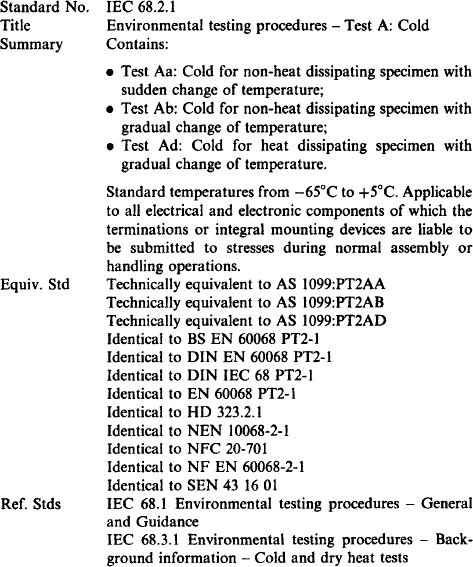
2.4.1.1 Introduction
Whilst air temperatures around –25°C are often recorded in Central Europe, in some of the more uninhabited regions (e.g. Switzerland) minimum temperatures often go down to –40°C. Granted operational equipment will rarely be subjected to such severe conditions, but some electronic equipment may occasionally be stored or installed for several weeks before actually being brought into service and could quite likely be exposed to these extreme conditions.
One problem to be contended with is that when temperatures as low as –40°C are reached, many failures can occur due to the different coefficient of thermal expansion of the various materials, for instance:
2.4.1.2 Purpose of this test
The purpose of test IEC 68.2.1 is to:
• determine the suitability of heat generating and non heat generating equipment during operation, storage, or whilst being transported at extremely low temperatures;
• provide a procedure to determine the effect of subjecting samples of equipment (that are intended to be used or stored at low temperatures) to sudden changes of temperature.
The cold tests are subdivided into two categories as shown in Figure 2.4.
2.4.1.3 General conditions
An item of equipment is considered heat dissipating only if the hottest point on its surface, measured in free air conditions (i.e. with no forced air circulation) is more than 5°C above the ambient temperature of the surrounding atmosphere after temperature stability has been reached.
Note: No external heating measures are permitted in order for the sample to pass this test.
2.4.1.4 Test conditions
IEC 68.2.1 provides details of cold (i.e. low temperature) tests for sudden and gradual changes of temperature, for both heat dissipating and non-heat dissipating samples.
Samples shall be turned on and be fully operational (including displays) within the specified time (according to the procuring specification) at the specified temperature.
Samples must be capable of being fully operational (according to the procuring specification) after temperature shock testing.
2.4.1.5 Other standards
Other standards that are frequently referred to when testing for low temperatures include:
| IEC 68.2.39 | Environmental testing procedures – Test Z/AMD: Combined sequential cold, low air pressure and damp heat test |
| IEC 68.2.40 | Environmental testing procedures – Test Z/AM: Combined cold low air pressure tests |
| IEC 68.2.50 | Environmental testing procedures- Test Z/AFc: Combined cold vibration (sinusoidal) tests for both heat dissipating and non-heat dissipating specimens |
2.4.2 Dry heat test (IEC 68.2.2. Test B)
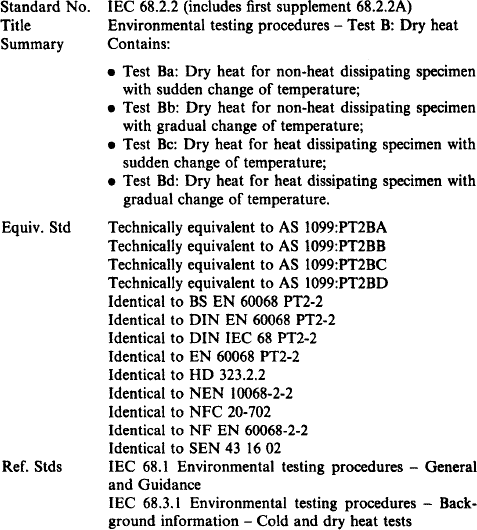
2.4.2.1 Introduction
Dry heat is a particular problem for almost all types of electronic equipment as it accelerates the development of chemical processes, thus speeding up the ageing of materials. In extreme cases semiconductors will often attain the conductive properties of metals (i.e. electrons are raised into the conduction band) and occasionally the internal temperature of electronic equipment will reach values where materials with a low melting point may begin to soften or flow (e.g. the protective wax of ‘sweating’ resistors).
Whilst the chief source of heat is the sun, losses due to power dissipation must also be considered.
2.4.2.2 Purpose of this test
The purpose of test IEC 68.2.2 is to:
• determine the suitability of heat generating and non-heat generating samples for operation at high temperatures;
• determine the suitability of heat generating and non-heat generating samples to survive storage at high temperatures;
• determine the ageing effects of high temperature on electronic equipment;
• provide a procedure to determine the effect of subjecting electronic equipment whilst operational (or stored at high temperature) to sudden changes of temperature.
The dry heat tests are subdivided into categories as shown in Figure 2.5.
2.4.2.3 General conditions
No external cooling methods are allowed in order to pass this test.
It is appreciated that certain difficulties may arise due to the fact that heat transfer is associated with temperature gradients and that the temperature of the medium surrounding the device will vary in space. It is a requirement, therefore, that the ‘ambient temperature’ of the surrounding atmosphere is accurately defined and for this purpose:
• the yearly average external open-air temperature is conventionally taken as 25°C;
• the yearly average external temperature inside equipment housing or ‘cubicles’ is conventionally taken as 55°C.
External air temperatures in special locations (such as satellite terminals on top of buildings) may exceed the normal open-air temperature.
2.4.2.4 Test conditions
IEC 68.2.2 provides details of dry heat (i.e. high temperature) tests for both sudden and gradual changes of temperature, in both heat dissipating and non-heat dissipating electronic equipment.
Note: An item of equipment is considered heat dissipating only if the hottest point on its surface, measured in free air conditions (i.e. with no forced air circulation), is more than 5°C above the ambient temperature of the surrounding atmosphere after temperature stability has been reached.
It is not uncommon for equipment (especially when installed inside cubicles) to endure short-term start-up thermal conditions of up to 10°C over the steady state temperature range. If this does occur, then the full performance ratings may be relaxed if this is acceptable (and agreed with the end user) for the type of service required.
Samples are normally required to be capable of being fully operational (according to the procuring specification) after temperature shock testing and to be fully operational (including displays) within 30 seconds of being switched on, at the specified temperature.
2.4.2.5 Other standards
Other standards that could be considered are:
| IEC 68.2.51 | Environmental testing procedures – Test Z/BFc: Combined cold vibration (sinusoidal) tests for both heat dissipating and non-heat dissipating specimens |
| IEC 68.3.1 | Environmental testing procedures – Background information – Cold and dry heat tests |
2.4.3 Change of temperature test (IEC 68.2.14 Test N)
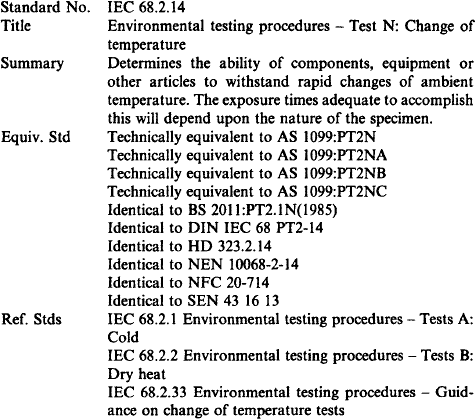
2.4.3.1 Introduction
Electronic equipment will normally only experience gradual changes of temperature and internal components will normally only have to tolerate relatively slower changes of temperature than those experienced by the external surfaces.
Rapid changes of temperature may, however, be expected:
• when equipment is being transported and/or stored;
• when equipment is transported from a warm indoor environment into a cold air conditioned environment or vice versa (see also Chapter 4);
• when equipment is externally mounted;
• when equipment is suddenly cooled by rain or immersed in cold water;
• when a cooling system is switched on;
• when high temperature gradients have built up in equipment after switching on (e.g. in the vicinity of high wattage resistors).
2.4.3.3 General
The change of temperature (or temperature shock) test is intended to determine the effect of a change of temperature (or a succession of changes of temperature) on samples. It is not intended that the test should show effects that are due only to low or high temperatures as described in paragraphs 2.4.1 and 2.4.2.
Notes: Quick changes of temperature (i.e. temperature gradients) may result in the destruction of electronic components, due to mechanical stresses.
Equipment manufacturers normally recommend that the number of switching-on operations are kept to a minimum and that the equipment is always pre-heated whenever possible.
2.4.3.4 Test conditions
Samples are subjected to temperature shock testing as specified in IEC 68.2.14 (depicted in Figure 2.6), by alternate and rapid exposure to low and high temperatures in air, or in a suitable inert gas.
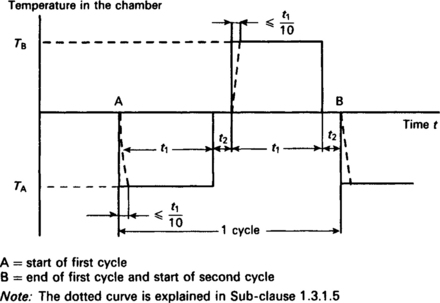
Fig. 2.6 Ambient temperature – temperature shock testing (reproduced from the equivalent standard BS 2011 Part 2.1 N:1985 by kind permission of the BSI)
• the severity of the test is a combination of two temperatures chosen from IEC 68.2.1 and IEC 68.2.2;
• the transition time and the number of shock cycles are as specified in IEC 68.2.14;
• the sample is not required to operate during testing;
• the sample must be capable of being fully operational (according to the procuring specification) after completion of temperature shock testing.
Verification of good temperature design of all installed equipment shall be agreed between the purchaser and supplier. This shall include:
2.4.4 Combined dry heat/low air pressure test (IEC 68.2.41 Test Z/BM)


2.4.4.1 Introduction
Components, equipment or other articles whilst operational (and particularly whilst in transit) are frequently subjected to a simultaneous combination of high temperature and low air pressure.
2.4.4.2 Purpose of this test
The purpose of test IEC 68.2.41 is to:
• provide a standard test procedure that can be used to determine the suitability of a sample (heat dissipating or non-heat dissipating) that is intended to be used or stored in a combination of high temperature and low air pressure;
• describe a composite test aimed at determining the suitability of a specimen to a simultaneous combination of high temperature and low air pressure.
2.4.4.3 General
This test is a combination of high temperature (paragraph 2.4.2) and low air pressure tests (paragraph 5.4.1) and can be used to test heat dissipating equipment in their operational state as well as non-heat dissipating equipment in their operational or stored states.
2.4.4.4 Test conditions
In this test the specimen is first exposed to a high temperature and then (with the temperature value maintained) the air pressure within the test chamber is reduced. The severity of the test is a combination of temperature, air pressure and duration of exposure.
2.4.4.5 Other standards
Other standards that could be considered are:
| IEC 68.2.51 | Environmental testing procedures – Test Z/BFc: Combined dry heat vibration (sinusoidal) tests for both heat dissipating and non-heat dissipating specimens |
| IEC 68.3.1 | Environmental testing procedures – Background information-Cold and dry heat tests |
| IEC 68.3.2 | Environmental testing procedures – Background information-Combined temperature/low air pressure tests |
2.4.5 Climatic sequence test (IEC 68.2.61. Test Z/ABDM)

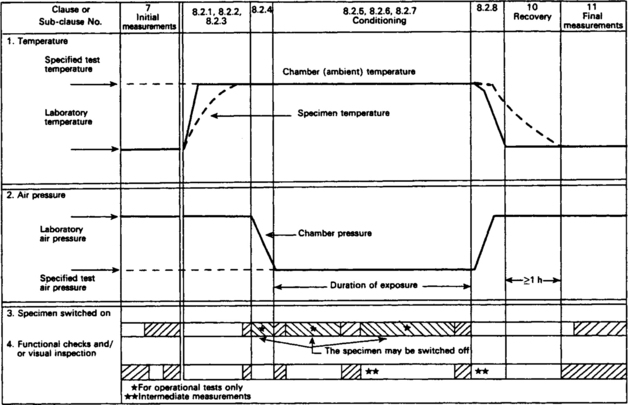
Fig. 2.7 Test profile for non-heat dissipating specimens (reproduced from the equivalent standard BS 2011 Part 2.1Z/BM;1977 by kind permission of the BSI)

Fig. 2.8 Test profile for heat dissipating specimens (reproduced from the equivalent standard BS 2011 Part 2.1Z/BM;1977 by kind permission of the BSI)
2.4.5.1 Introduction
Electronic equipment whilst in use (and particularly during transit) can be frequently subjected to environmental conditions consisting of a sequence of temperature, humidity and low air pressure environmental stresses.
2.4.5.2 Purpose of this test
The purpose of test IEC 68.2.61 is to determine the suitability of electronic equipment when subjected to environmental conditions consisting of a sequence of high temperature, low temperature, humidity and (when required) low air pressure environmental stresses.
2.4.5.3 General
This test is frequently specified to follow other tests involving mechanical stress (e.g. tests for the robustness of terminations, solderability, shock and vibration) and is used as a means of determining whether the sealing of a specimen has been damaged by such stress.
2.4.5.4 Test conditions
IEC 68.2.61 describes a composite test for assessing the suitability of samples to a ‘climatic sequence’ of tests as shown in Figure 2.9.
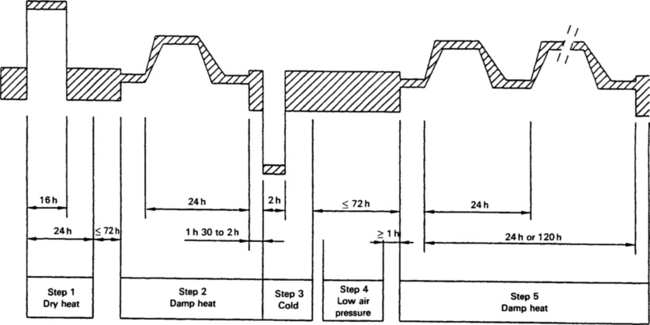
Fig. 2.9 Diagrammatic sequence of the progress of the climatic sequence (reproduced from the equivalent standard BS EN 60068.2.61 by kind permission of the BSI)
In this test the specimen is first exposed to a high temperature and then a cycle of damp heat. This is immediately followed by a low temperature test so that any moisture which has entered either the specimen or via surface cracks in its seals will be frozen and cause further damage.
Low air pressure is then followed by further exposure to cyclic damp heat conditions and (if required) the severity of the test can be increased by completing a low temperature test in between each of the five final damp heat cycles.
2.4.5.5 Other standards
| IEC 68.2.1 | Environmental testing procedures – Test A: Cold |
| IEC 68.2.13 | Environmental testing procedures – Test M: Low air pressure |
| IEC 68.2.2/2A | Environmental testing procedures – Test B: Dry heat (and supplement) |
| IEC 68.2.28 | Environmental testing procedures – Guidance – Damp heat tests |
| IEC 68.2.30 | Environmental testing procedures – Test Db and guidance: Damp heat, cyclic (12 + 12 hour cycle) |



